THANK YOU FOR SUBSCRIBING
Be first to read the latest tech news, Industry Leader's Insights, and CIO interviews of medium and large enterprises exclusively from Education Technology Insights
The Power of Gamified Learning and VR Applications
The quest for innovative learning methods continues unabated in the evolving landscape of higher education.

By
Education Technology Insights | Wednesday, September 20, 2023
Stay ahead of the industry with exclusive feature stories on the top companies, expert insights and the latest news delivered straight to your inbox. Subscribe today.
Gamified learning and VR applications are revolutionising education by offering real-world simulations, instant feedback, personalised experiences, and intrinsic motivation, creating engaging and effective learning environments for students.
FREMONT, CA: The quest for innovative learning methods continues unabated in the evolving landscape of higher education. While educators tirelessly seek ways to engage students and enhance their academic experiences, one approach has emerged as a game-changer: gamified learning. By seamlessly blending technology, gaming, and education, this dynamic tactic is revolutionising the educational space in profound ways.
One of the most striking transformations is the shift towards real-world simulations and experiences within the classroom. The days of costly off-campus trips are gone, as students can now immerse themselves in real-world scenarios from the safety of their controlled environments. Through simulations, they can actively engage in practical problem-solving, decision-making, and critical thinking activities. For instance, classrooms can utilise cutting-edge virtual reality (VR) technologies to recreate historical events. Even gaming applications enable the recreation of historical catastrophes like the eruption of Mount Vesuvius, aiding in the comprehension of events such as the devastation of Pompeii.
The potential of VR applications helps enhance learners' focus and productivity at a reduced cost. Career and technical education centres are harnessing these attributes, and many universities are integrating VR applications. Nursing schools, for example, employ VR to simulate medical procedures, while engineers simulate scenarios such as repairing hardware atop electrical poles. This hands-on approach fosters transformative learning and bridges the gap between academia and the real world.
Gamified learning and VR applications also offer the invaluable benefit of instant feedback and knowledge retention. These innovations provide real-time feedback to students in engaging, educational ways, helping them learn from their mistakes immediately. This boosts student motivation and knowledge retention, empowering them to address weaknesses and build on strengths promptly.
Personalised learning experiences have become a reality through adaptive technologies. Platforms can now tailor content and challenges to match individual learning styles and paces. For instance, if a student struggles with addition, the system will offer more practice in that area before progressing to subtraction. This personalised experience can be gamified as students level up their digital skills alongside their academic progress. Allowing students to take ownership of their learning journeys at their own pace promises better academic outcomes.
Gamified learning incorporates intrinsic motivation elements like badges, progress tracking, and leaderboards. This approach inspires students to strive for their goals, believe in their potential, and become their best selves. Social elements, crucial for skill development, are also integrated into gamified learning, promoting social connections, collaborative problem-solving, communication skills, and a positive learning environment. Esports, in particular, provide a unique avenue for students to compete while honing skills relevant to the tech-driven businesses of the future, including broadcasting, programming, hardware development, marketing, branding, and communications.
As the demand for gamified learning and VR applications in education continues to rise, institutions seek reliable partners to guide them on this transformative journey. Coupled with VR, AR, and XR technologies, these initiatives open up a world of opportunities for educators and students alike, ushering in a new era of engaging and effective education.







